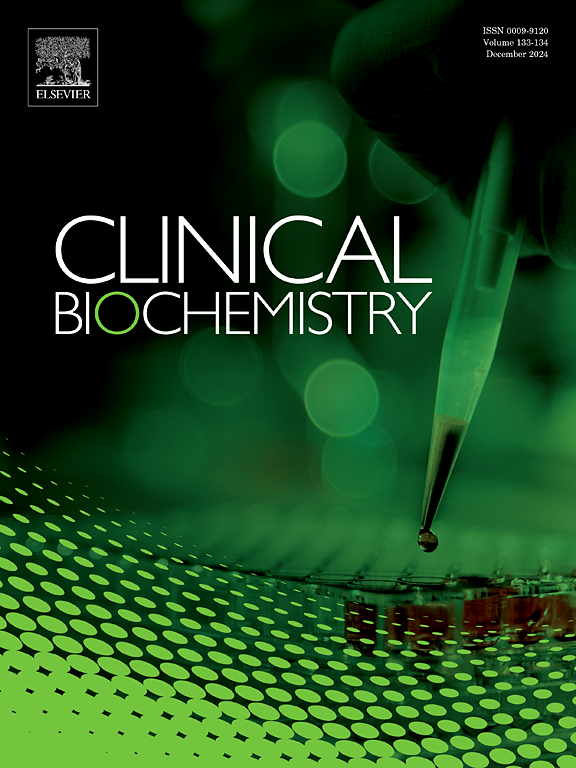ECMO患者游离血浆血红蛋白监测:二阶导数分光光度法与溶血指标的双中心比较研究。
IF 2.1
3区 医学
Q2 MEDICAL LABORATORY TECHNOLOGY
引用次数: 0
摘要
背景和目的:体外膜氧合(ECMO)可诱导大量血管内溶血,通常通过血浆游离血红蛋白(fHb)测量来定量。虽然使用二阶导数分光光度法(sDS)的手动分光光度法是参考方法,但最近开发了一种基于溶血指数(HI)的评估工具,用于在不同的自动化系统上测定血红蛋白。本研究比较了两种HI方法(Roche Cobas c502和Abbott Architect c16000)与sDS在83例ECMO患者中的表现。材料和方法:在两种自动化HI系统上进行方法验证,包括确定线性度、精密度以及血脂和黄疸的分析干扰。对来自两家医院中心的83名ECMO患者的血浆fHb测量进行了两种hi衍生方法和两种手动sDS方法(在415 nm和578 nm处)的比较。结果:两种方法均具有良好的线性关系(0.04 ~ 20 g/L)和重复性(CVs在2.3 % ~ 6.3 %之间)。然而,它们对高血脂指数的干扰表现出敏感性,导致雅培建筑师对fHb的低估和罗氏Cobas对fHb的高估。在fHb水平为>0.10 g/L的非血脂性ECMO样品中,HI和sDS之间存在非常好的相关性,特别是在578 nm处。然而,在血脂样本中观察到差异,导致fHb值>0.50 g/L的临床相关偏差。结论:Roche Cobas和Abbott Architect HI方法是监测ECMO患者fHb的可靠工具,具有良好的重现性和线性。然而,在存在明显的脂血症时,建议通过sDS确认以确保准确评估溶血。这种方法促进了fHb的有效和自动化监测,对于日常管理ecmo相关并发症和改善患者预后至关重要。本文章由计算机程序翻译,如有差异,请以英文原文为准。
Monitoring free plasma hemoglobin in ECMO patients: a two-center comparative study of second-derivative spectrophotometry and hemolysis indexes
Background and aims
Extracorporeal membrane oxygenation (ECMO) can induce massive intravascular hemolysis, commonly quantified by plasma free hemoglobin (fHb) measurement. While manual spectrophotometry using second derivative spectrophotometry (sDS) is the reference method, a recent assessment tool based on the hemolysis index (HI) was developed for fHb determination on different automated systems. This study compares the performance of two HI methods—on Roche Cobas c502 and Abbott Architect c16000—versus sDS in 83 ECMO patients.
Materials and methods
Method validation was performed on both automated HI systems, including determination of linearity, precision, and analytical interference from lipemia and icterus. Plasma fHb measurements in 83 ECMO patients from two hospital centers were compared between the two HI-derived methods and two manual sDS methods (at 415 nm and 578 nm).
Results
Both HI-automated methods showed excellent linearity (0.04–20 g/L) and reproducibility (CVs between 2.3 % and 6.3 %). However, they exhibited sensitivity to interference by high lipemic index, leading to underestimation of fHb for Abbott Architect and overestimation for Roche Cobas. In non-lipemic ECMO samples with fHb levels >0.10 g/L, a very good correlation was found between HI and sDS, especially at 578 nm. However, discrepancies were observed in lipemic samples, leading to clinically relevant biases for fHb values >0.50 g/L.
Conclusion
The Roche Cobas and Abbott Architect HI methods are reliable tools for monitoring fHb in ECMO patients, with good reproducibility and linearity. However, in the presence of significant lipemia, confirmation by sDS is recommended to ensure accurate assessment of hemolysis. This approach facilitates an efficient and automated monitoring of fHb, essential for daily managing ECMO-related complications and improving patient outcomes.
求助全文
通过发布文献求助,成功后即可免费获取论文全文。
去求助
来源期刊

Clinical biochemistry
医学-医学实验技术
CiteScore
5.10
自引率
0.00%
发文量
151
审稿时长
25 days
期刊介绍:
Clinical Biochemistry publishes articles relating to clinical chemistry, molecular biology and genetics, therapeutic drug monitoring and toxicology, laboratory immunology and laboratory medicine in general, with the focus on analytical and clinical investigation of laboratory tests in humans used for diagnosis, prognosis, treatment and therapy, and monitoring of disease.
 求助内容:
求助内容: 应助结果提醒方式:
应助结果提醒方式:


